One of the biggest benefits of content marketing is being able to build an audience – rather than renting that audience through advertising. The number one way to stay in touch with that audience is email, but it’s often used just as a channel for sales instead of sharing your brand’s content.
The fact is, even though 80% of content marketers are using email, most could stand to improve their strategy. An Epsilon report found that the average click rate for marketing emails was just 3.9% in the first quarter of 2015. If you’re pouring your heart and soul into creating great content, that simply won’t do.
It’s easy to find data on email marketing by sector — i.e. finance, media, technology, etc. — but it’s nearly impossible to find good data on email effectiveness by strategy.
The data says that consumers just aren’t interested in receiving B2B emails — their click rates hover just above 2% — but if you’re in the media business, you can expect nearly triple the clicks. Generalized data like this could lead marketers to falsely conclude that their customers simply aren’t interested in certain topics. Nothing could be further from the truth.
Email is a permission-based marketing channel. If someone has signed up to receive your emails, they are explicitly requesting more information. They need to educate themselves on a topic, or maybe they have a problem that your product can solve. I encourage you to glance at the data on email marketing, then ignore it. The best marketers always think outside the box. If you’re prepared to give some real thought to your emails and perform a few tests, you’ll soon scoff at 4% click rates.
In this post, I’ll outline 10 email marketing tips you can apply to drive more people to your content. These suggestions can be used in any sector and most can be combined for an even greater effect.
1. Stay focused
If you want people to click on your emails, make it as simple as possible. Anything in the email besides the link and a few lines of enticing copy is a distraction from that goal.
Take Help Scout for example. They’ve sent dozens of emails with the same simple format:
- Headline
- Image
- Teaser
- Button
Don’t let the simplicity of their approach lead you to believe they don’t take email seriously. As Help Scout’s content strategist Greg Ciotti wrote on the company blog, “email should be the core of every content marketing strategy.”
The absence of friction draws the eye to the call to action, making the click a forgone conclusion. They never stray from this formula because it works.
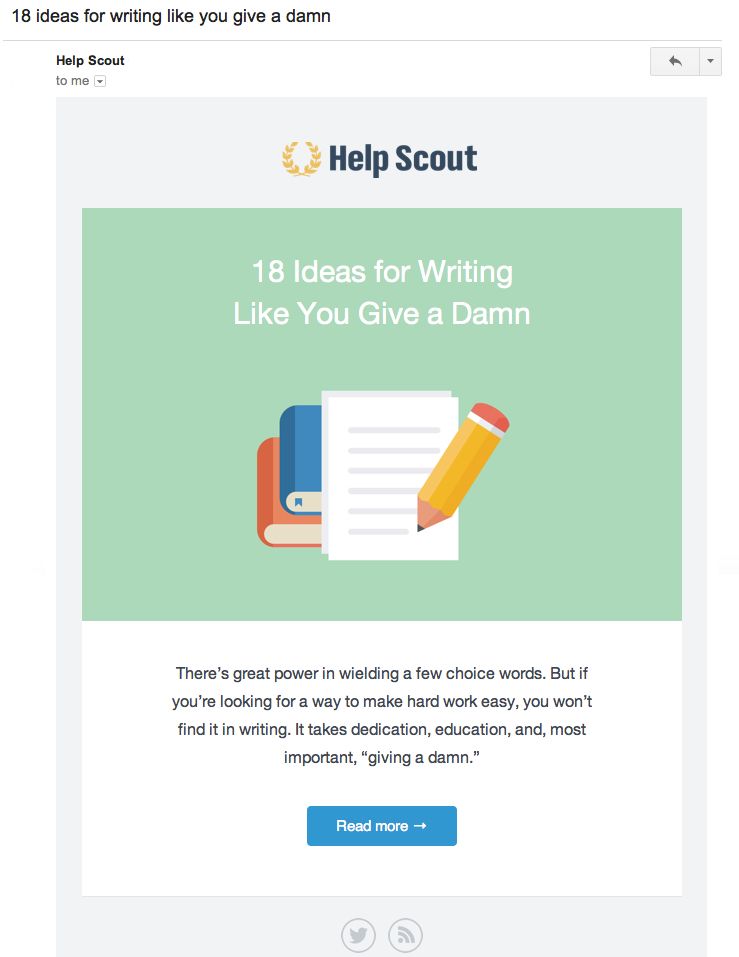
2. Use behavioral data
Quora finds itself in a unique position. Their user-generated content model creates so much content that they need to scour their data to figure out what to include in their emails.
It’s not a bad problem to have, and every marketer can learn from the solution they’ve devised. Quora personalizes emails based on everything they know about their subscribers. For example, I received the following email based on topics I follow, questions I’ve answered and links I’ve clicked, as well as popular content they think I might be interested in.
This means that no two Quora users receive the same email. This model works for an organization with massive amounts of content, and it creates intriguing emails every time.
One other important thing to note about Quora’s emails is the implementation of social proof. They use the names and faces of the users who created the content, and they show the number of people who have upvoted it. This not only validates the content but encourages email recipients to join an active and inclusive community.
If you can find a way to work behavioral data and social proof into your emails, do it.
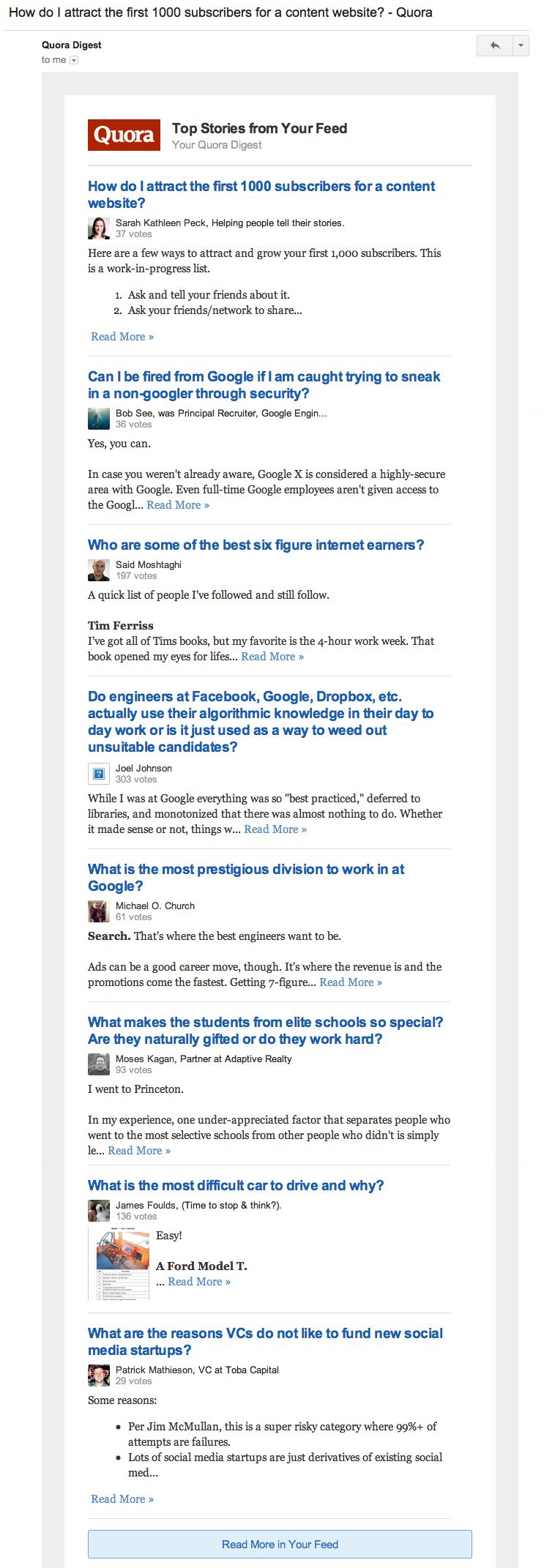
3. Use compelling images
In this post, I’ll recommend that you use images, then later suggest that you don’t. Both strategies work for the right audience. Let me explain.
Images should be part of your content strategy, not your conversion strategy. Images should add context or help readers visualize your ideas. This enhances the reader experience. Including stock images or other unrelated visual content in your emails is a distraction. (Remember tip #1: Stay focused!)
The chart in this email is a visual teaser, encouraging the reader to continue to the site to learn more on the topic. It also adds value on its own, meaning that readers can have a positive experience with Outbrain without leaving their inbox.
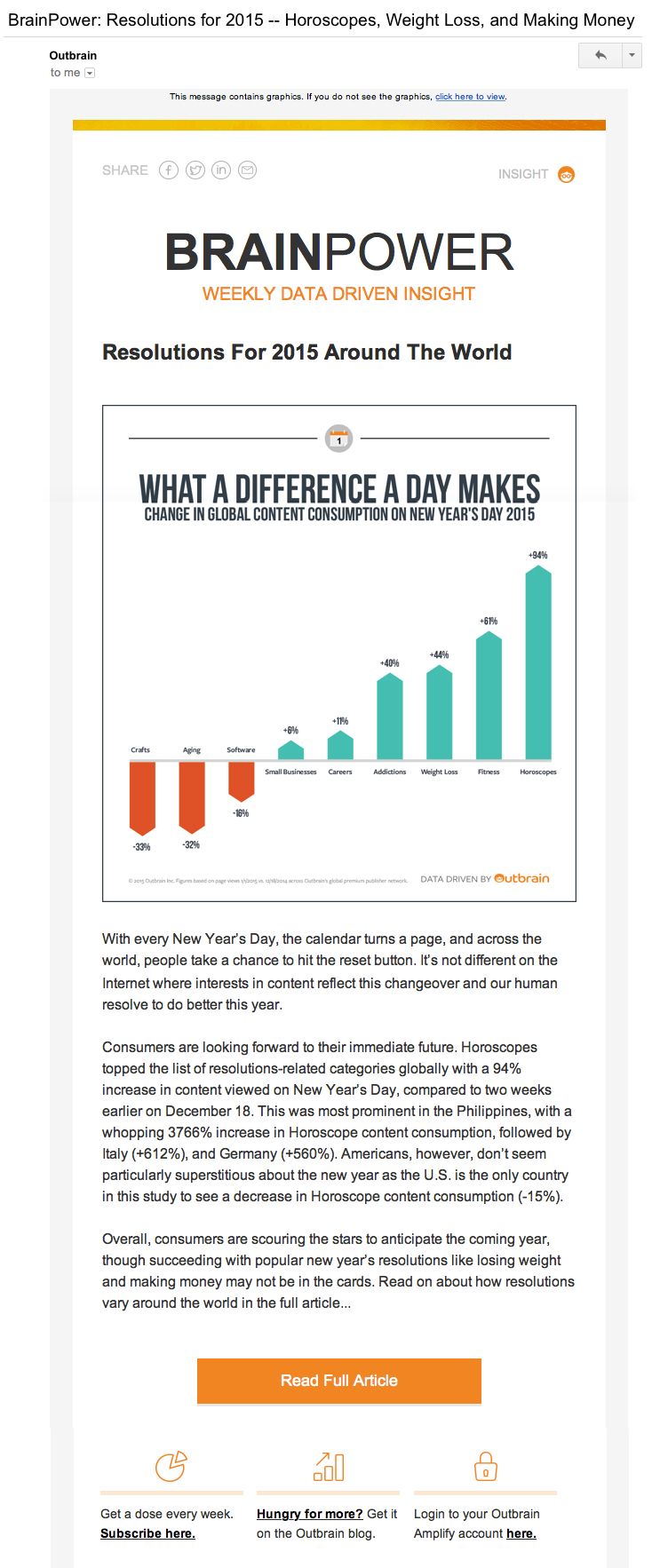
4. Curate
This may seem counter intuitive, but if you’re sending content-driven emails, consider including content that you didn’t write.
I know, it seems odd. But think about your readers. They need education, advice or inspiration. If someone has already provided that, share it with them. By sending more useful content without creating more, you’re making your own life easier too.
The curation mantra is send them away to bring them back. Zach Seward, executive editor at Quartz and curator, explains:
Our goals are just to cite our sources, acknowledge that there’s a whole wide world of great business reporting, and point our readers to material they should see … We’re thrilled if readers leave Quartz because we’ve pointed them to great material elsewhere because we know they’ll love us for it and come back for more.
One newsletter that embodies this strategy perfectly is Dave Verwer’s iOS Dev Weekly. Each week, he delivers a newsletter full of links that are relevant to his audience of more than 36,000 developers and designers. Even though he sends them all over the web, he is the information broker.
Dave has earned a reputation as a trusted source of news and information in his niche. While you may primarily be a content creator, you can still leverage curation to add value to your emails and keep your readers happy and engaged.
These emails are massive. See the full issue online here.
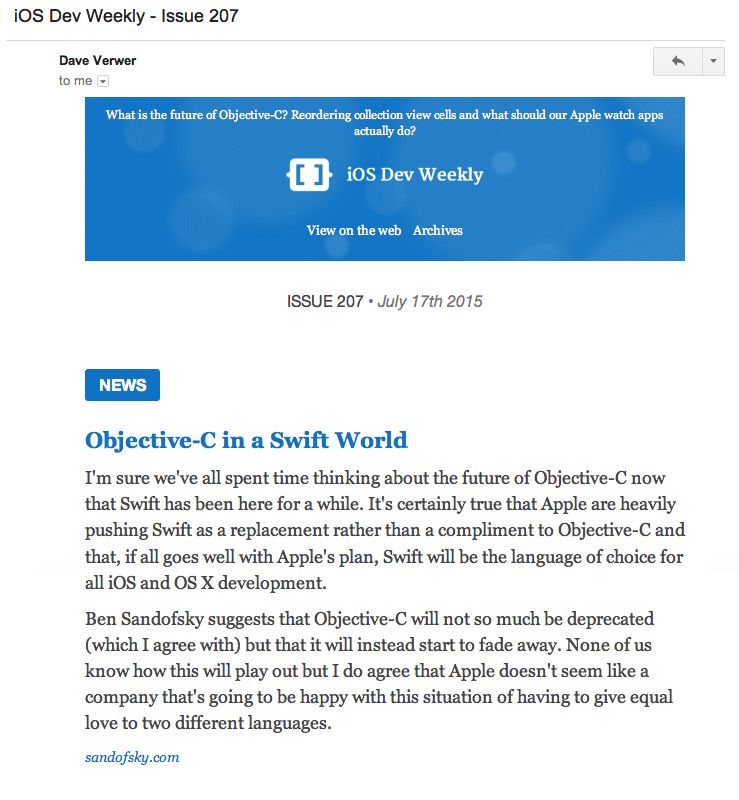
5. Take conversion seriously
There are many things content marketers can learn from journalists. How to write on a deadline, the important of copyediting and fact-checking, and the ins-and-outs of AP Style. But there are also a few things that journalists can learn from content marketing — primarily the importance of conversion.
Here’s what I mean.
Each week, I receive the New York Times Small Business Newsletter. The articles are great but the newsletter is haphazard. It isn’t clear where to click first and that could mean some readers abandon the email altogether. It is clearly assembled by an editorial team rather than a marketing team. (Here’s a sample newsletter so you can see what I mean.)
Compare this to Zapier’s newsletter, which uses its real estate to sell the reader on clicking. Zapier’s email is conversion-focused. The goal is clear even to the reader, who happily obliges after skimming the first few lines of copy.
The real difference between the New York Times email and Zapier’s email is that Zapier has a pre-defined goal. They channel their creative energy into an email that is focused only on that goal.
In this case, the conversion goal is driving readers to their blog. They also use a button, which is one of the best ways to increase click-through rates. (Campaign Monitor reported a 28% increase in click-through rates when they changed text links to buttons!)
Whatever your goal, remove as many elements as possible. Everything besides a tease and a call to action is just a distraction.
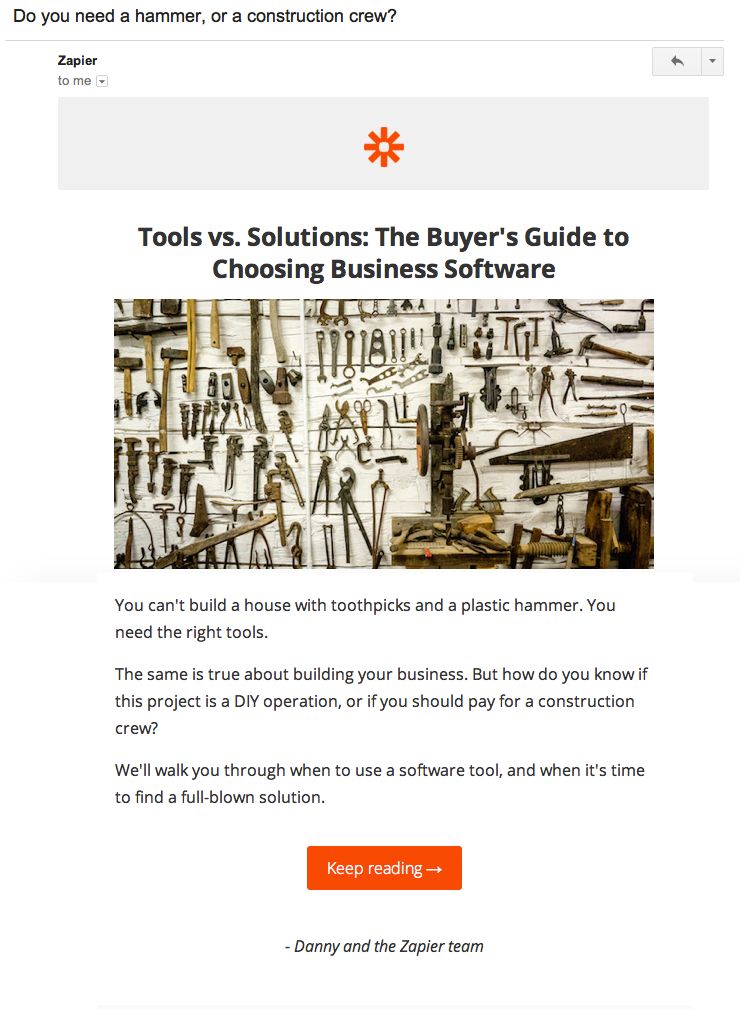
6. Put content ahead of design
You can’t put lipstick on a pig.
If you take content seriously, your emails should reflect it. Beautiful, mobile-responsive emails are nice but content comes first. I’ll let designer and entrepreneur Nathan Barry explain:
The best way to market online is to teach, to regularly deliver valuable content to your audience so that they will trust you and eventually want to purchase from you. So when you send an email, what part of the communication delivers the most value?
That’s right, the content. So we should be stripping away everything else that isn’t necessary in order to focus on the content. Multi-column layouts, background images, logos, and all the other nonsense that typically fills marketing emails doesn’t deliver value to the recipient. Instead it is all about you, the sender. Flip that around and start delivering value.
If you’re familiar with the Priceonomics blog, you’ll appreciate this example. Their content is detailed, entertaining and informative but their emails are stripped down — even barren. Interestingly, in an interview with Digiday, Copyblogger’s Brian Clark said of Priceonomics, “I love getting their emails.”
He isn’t talking about the way they look, he’s talking about the content. Priceonomics emails move the reader from the inbox to their site with as little friction as possible. And that is something to all content-driven emails should strive to accomplish.
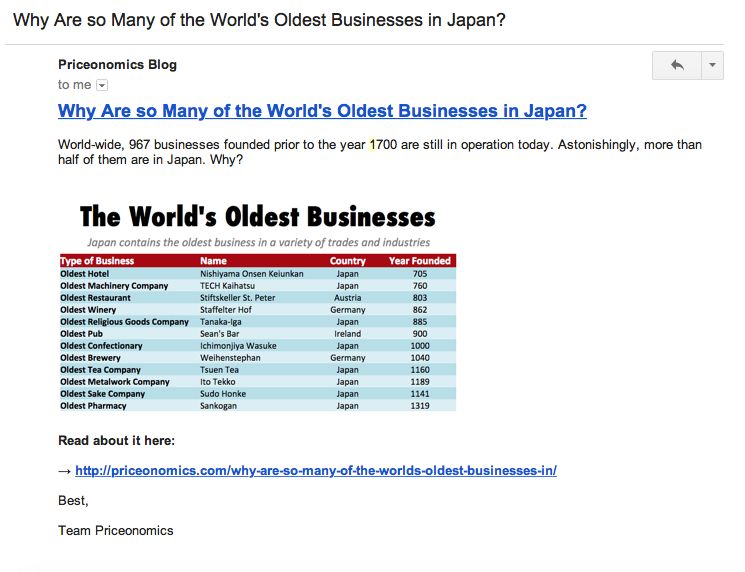
7. Be expected
One of the biggest mistakes email marketers make is showing up in the inbox unexpected. This is especially true for publishers, who should rely on the habit-forming nature of email to deliver regular, expected updates.
When you commit to a publishing schedule, you should also commit to an email schedule. And you should let people know what to expect even before they subscribe to your emails.
If, for example, you promise an email every day, you need to deliver on that promise. And if you set an expectation for occasional updates, don’t bombard people with daily emails.

This strategy is surprisingly underutilized. Most blogs use their email subscribe form to promise things like “free email updates.” What does that accomplish?
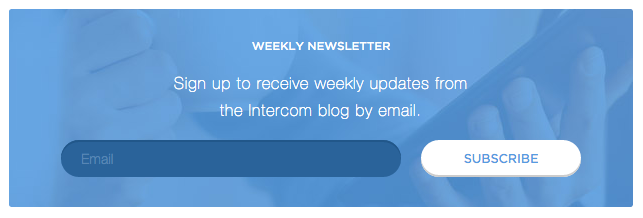
Instead, use the opportunity to set an expectation.
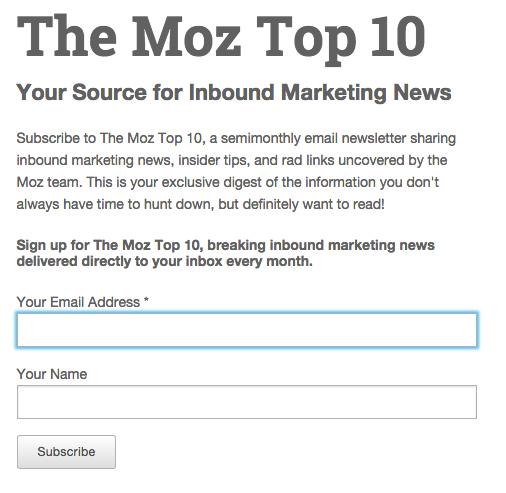
Once the expectation is set, you should overdeliver — but do it with great content, ideas and education, not more emails.
8. Do what’s best for the reader
At the end of the day, click-through rates are largely a vanity metric. What you really want out from your emails isn’t pageviews … it’s trust.
Sometimes you can accomplish that goal without ever asking the reader to click at all. Take Seth Godin’s emails as an example. He publishes one of the most popular marketing blogs in the world and he includes the full text of every article inside his emails.
There are options to click-through to the site but it’s not required. As the father of permission-based marketing, Seth understands that including his content in his emails is best for his readers. His goal is spread ideas, not beef up page views.
I’m not suggesting this is right for every content strategy but it’s a mindset that can work wonders for growing an audience.
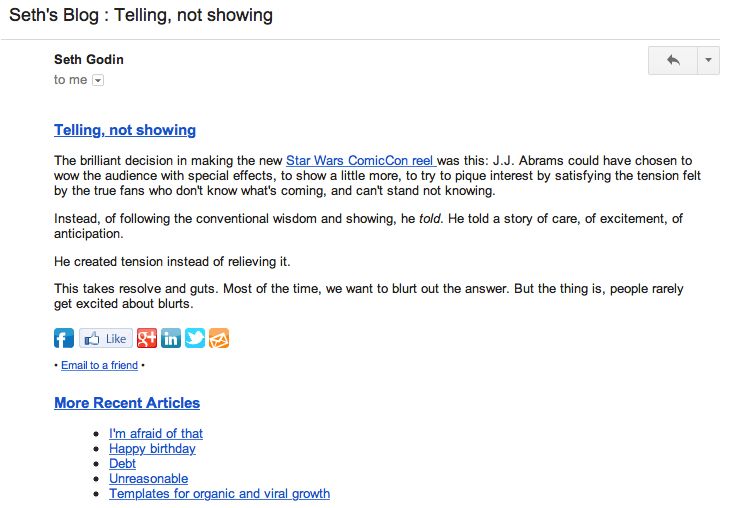
9. Be personal
For some reason, email marketers often write in the third person, sending emails from behind a cloak of invisibility. Too many emails lack personality and personableness. The further you stray from writing as yourself, the harder it is for the reader to connect.
Writing emails and signing them with your own name adds a bit of pressure to the publishing process. Are you proud enough of your content and this email to sign your name on it? Do you stand behind it?
To quote Mark Traphagen on the Moz blog:
It’s a simple fact of human psychology: people will identify with and trust a person long before they’ll give the same consideration to a faceless brand.
If you want to earn trust, let your readers know that you believe in your own work by attaching your name and face to it.

10. Include content in all of your emails…
… if, of course, it’s helpful to the recipient.
In addition to your newsletter and promotional emails, you likely send automated emails in the form of welcome messages, invoices, notifications and receipts. There are many scenarios where content can add valuable context to these emails.
Take a look at the welcome email for the photography blog ShotKit. It includes all the information you need about Mark (the publisher), links to the best posts and more information about the site. It’s an onboarding email for new readers.
Automated emails are actually a great way to get readers engaged in your best work. Because they are triggered as result of action — subscribing to your blog, making a purchase, downloading an e-book, etc. — they can become a key traffic source and a valuable resource for your customers.

✉️ Get an email when we publish new content:
Don't worry, we won't bug you with junk. Just great content marketing resources.
Ready To Try
Content Harmony?
Get your first 10 briefs for just $10
No trial limits or auto renewals. Just upgrade when you're ready.

You Might Also Like:
- The Wile E. Coyote Approach To Content Guidelines
- Content Brief Templates: 20 Free Downloads & Examples
- The Keyword Difficulty Myth
- How To Find Bottom of Funnel (BoFU) Keywords That Convert
- Bottom of Funnel Content: What Is BOFU Content & 10 Great Examples
- 20 Content Refresh Case Studies & Examples: How Updating Content Can Lead to a Tidal Wave of Traffic 🌊
- How to Create Editorial Guidelines [With 9+ Examples]
- Content Marketing Roles
- How To Write SEO-Focused Content Briefs
- The Content Optimization Framework: [Intent > Topic > UX]
- How To Update & Refresh Old Website Content (And Why)
- 12 Content Marketing KPIs Worth Tracking (And 3 That Aren't)
- 16 Best Content Writing Tools in 2024 (Free & Paid)
- How to Create a Content Marketing Strategy [+ Free Template]
- How To Create Content Marketing Proposals That Land The Best Clients
- What Is A Content Brief (And Why Is It Important)?
- How To Create A Dynamite Editorial Calendar [+ Free Spreadsheet Template]
- How to Use Content Marketing to Improve Customer Retention
- Types of Content Hubs: 5 Approaches & 30+ Examples
- How To Do A Content Marketing Quick Wins Analysis